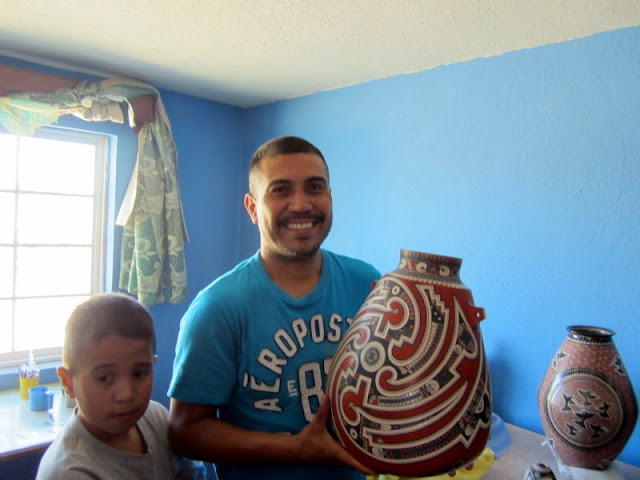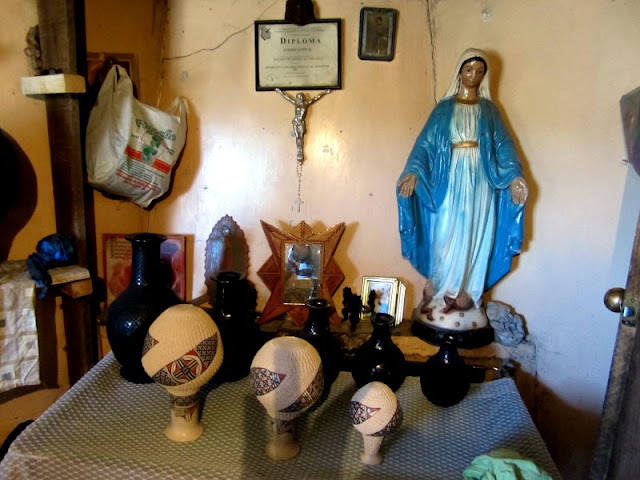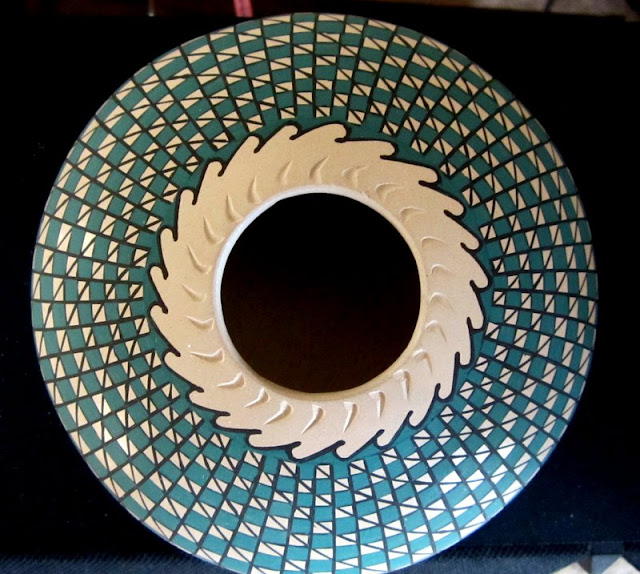 |
| Paquimé Ruins |
Few places within an easy morning's drive of the United States' border offer UNESCO World Heritage ruins to explore and world-class art to collect. If you'd like to know how people lived in 1100-1300 CE while you buy pottery from an artist who also sells his work to the Heard Museum in Phoenix, then Casas Grandes, Chihuahua, Mexico, is the place you'll want to visit. You will be amazed by the way the ancient Paquimé civilization led to the creation of the modern ceramic art created in nearby Mata Ortiz.
 |
| This is David's and my collection of black on black pottery. |
Just a few hours' drive south of the Douglas, AZ/Agua Prieta, MX or Palomas, MX, (Just south of Deming, NM) border crossings, Paquimé or Casas Grandes (big houses), is the former home of 2,000 Publeoans who built a city that consisted of apartments with
raised cooking hearths, heated sleeping platforms, and intricate passageways to get from one area to another. The three-story apartment buildings were built in a semi-circle which protected the public market, the main plaza, and the baths while, at the same time, hiding some private courtyards. This advanced society used sophisticated water control systems to supply running water to apartment areas and to clean the public plazas while the ball courts and ceremonial mounds were used for religious and athletic events. The guest quarters indicate that Paquimé was clearly on the trading route, and, judging from ceramic pottery jugs and shards that have been undearthed at the site, talented artists lived there creating the items used in trade. It is this very pottery that has made the area thrive once again.
 |
| Traditional Paquimé Design |
The story of how the sleepy, impoverished village of Mata Ortiz came to life again reads almost like a fairy tale. At the very least, the series of events that transformed this village is a minor miracle by anyone's standards.
When twelve-year-old Juan Quezada, always a loner, wandered the fields surrounding his home in the late 1950s, he found the ancient pottery shards of the Paquimé artisans and decided he would try to duplicate their work.
 |
| I love this modern interpretation of Day of the Dead. |
Working with only his bare hands to form the pots, he struggled for years to find the right clay, proper firing technique (using cow manure as the combustible and firing one piece at a time using rocks for a platform and metal cans for covers), and paintbrushes (one or two strands of thick, straight hair from a child's scalp) to paint the intricately detailed designs until he was finally producing pots he liked. But this young man, one of eleven children living in this poor, remote Mexican village had little chance of selling, or even showing, his work to an appreciative audience. That's when the first miracle occurred,
A traveling salesman received the gift of three pots, but, needing practical items more than art, he traded the pots for clothes in Deming, New Mexico, at Bob's Swap Shop. This unprepossessing spot is where Spencer MacCallum found them.
MacCallum, an anthropologist with a specialty in art history, accompanied his friend on a trip to Deming where he found the pots at Bob's. Intrigued by their symmetry and flair, he bought them and placed them on a shelf back home. He knew an extraordinarily talented person had created them, but he had little hope of finding the artist. He tried to forget the pots, but his mind returned to them again and again.
 |
| This is a Mata Ortiz artist's kitchen and warehouse for pots. |
Finally, he decided that at least he would return to Deming and see if the owners of Bob's Swap Shop knew anything about them. When he was directed to look in Mexico, MacCallum didn't give up hope. Instead, he took photos of the pots and began his search, stopping in every village in the state of Chihuahua to ask if anyone recognized the work. That's when the second miracle happened.
 |
| The kitchen table doubles as a space for painting pots. |
MacCallum's diligent questioning led him finally to the pot's creator--Juan Quezada in Mata Ortiz. MacCallum wanted to nourish this young man's talent although he had no idea how this poor artist from a village no one had ever heard of would get his work accepted. He finally decided that Quezada must dedicate himself to his art, rather than waste his talent farming. MacCallum promised him a modest stipend if he would dedicate himself to his art for three years. In the meantime, MacCallum would introduce the amazing creations to the world.
 |
| This award-winning artist is preparing for an upcoming show. |
Today, Quezada's pots sell for hundreds and thousands of dollars and are a part of museums' collections, including the Smithsonian's, world-wide. Even more importantly, because Quezada was willing to share his techniques with the other villagers in Mata Ortiz, this once poor village of 2,100, where workers formerly earned a few dollars a day, became prosperous with 400 or so new artists. They now earn what was formerly a week's wages with the sale of just one large pot!
 |
| Eventually, the pots (The ones in the foreground are upside down .) temporarily become part of the artist's home decor. |
Drive into this dusty, sere landscape where a former train station is the most prominent architectural feature, and you are immediately approached by artists who open a box or a car trunk to show you their masterpieces. A child will ask you to follow to a modest house where pieces are arranged on a bed or dresser, or an artist might have you follow her car to a house where special shelves hold a few beautiful pots. But don't neglect that train station. It's been turned into a cooperative where many potters' works are for sale at modest prices.
When you're in the artist's home, don't forget to notice the humble work places--a kitchen table covered by oil cloth--where this beautiful art is painted. You might see the "kiln," which usually consists of a firepit and a few bricks, if you look closely at the backyard.
 |
| The modern geometric designs are even more amazing when you realize everything is done by hand using home-made brushes. |
Plan to stay for a night or two. You will want to visit the excellent Paquimé museum and walk the ruins which have interpretive signs in English to help you understand this ancient civilization. You will also certainly want to buy a few Mata Ortiz pots of your own to help you remember this remarkable place where the ancients influence the pottery of today.
Practicalities -
Receiving a permit and driving across the border is quite easy with a bit of advance planning. Remember that you will need duplicates of all necessary documents which is much easier to do before you leave home. There will be a photocopy machine at the border, so don't despair if you forget a copy. See
this website for the list of documents you will need.
 |
| Officer removes the sticker when we cross back to US, |
While Chihuahua is considered one of the safest states in Mexico, you MUST have Mexican car insurance any time you cross the border. I have found
Lewis & Lewis to be one of the cheapest and best. David and I paid just under $50 US for four days in Mexico. You can, of course, find other insurance companies or perhaps your US provider can add a proviso for your visit.
Ron and Sue Bridgemon, Tucsonans who travel and lead tours to this area several times a year, maintain a
wonderful, detail-filled website with information about driving in Mexico, the many sites to see on your way to Mata Ortiz, and the best places to overnight and dine. Don't leave home without reading this site!
Prices at most stores and in individuals' homes will likely be in US dollars. If you prefer to deal in pesos, simply ask. Unlike most of Mexico, there is little bargaining unless you are buying five or six pieces from one artist. Even though dickering is inappropriate, the prices in Mata Ortiz are extremely reasonable--one-third to one-fourth what you will find in any Southwest gallery.

No comments:
Post a Comment